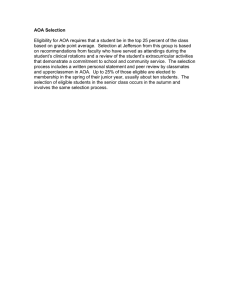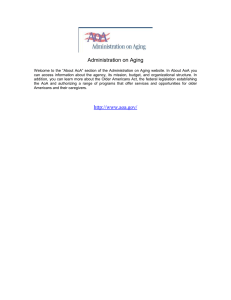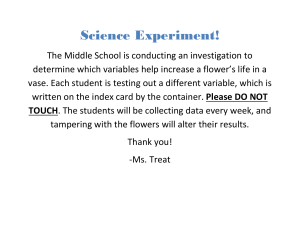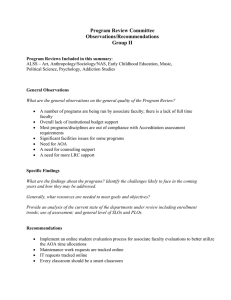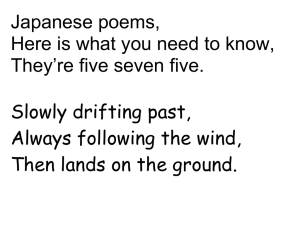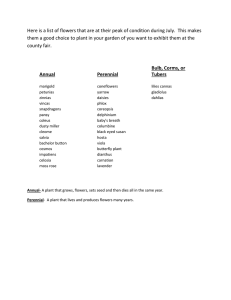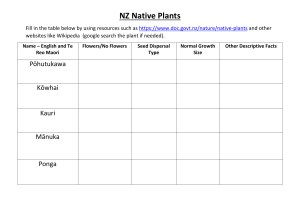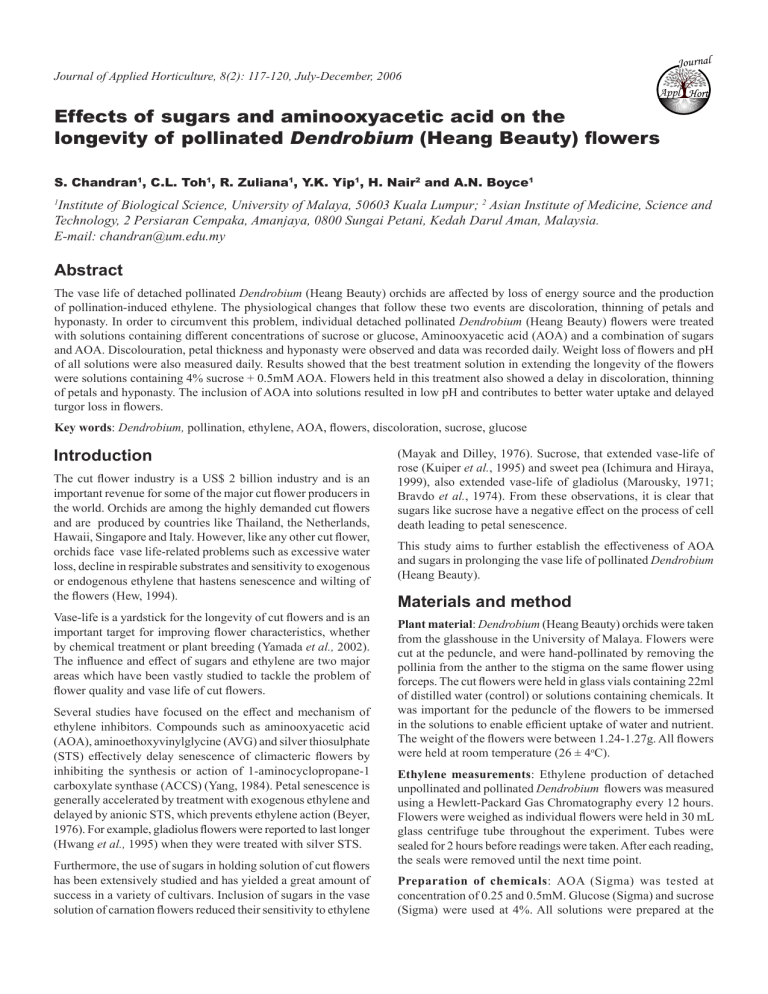
Journal Journal of Applied Horticulture, 8(2): 117-120, July-December, 2006 Appl Effects of sugars and aminooxyacetic acid on the longevity of pollinated Dendrobium (Heang Beauty) flowers S. Chandran1, C.L. Toh1, R. Zuliana1, Y.K. Yip1, H. Nair2 and A.N. Boyce1 Institute of Biological Science, University of Malaya, 50603 Kuala Lumpur; 2 Asian Institute of Medicine, Science and Technology, 2 Persiaran Cempaka, Amanjaya, 0800 Sungai Petani, Kedah Darul Aman, Malaysia. E-mail: chandran@um.edu.my 1 Abstract The vase life of detached pollinated Dendrobium (Heang Beauty) orchids are affected by loss of energy source and the production of pollination-induced ethylene. The physiological changes that follow these two events are discoloration, thinning of petals and hyponasty. In order to circumvent this problem, individual detached pollinated Dendrobium (Heang Beauty) flowers were treated with solutions containing different concentrations of sucrose or glucose, Aminooxyacetic acid (AOA) and a combination of sugars and AOA. Discolouration, petal thickness and hyponasty were observed and data was recorded daily. Weight loss of flowers and pH of all solutions were also measured daily. Results showed that the best treatment solution in extending the longevity of the flowers were solutions containing 4% sucrose + 0.5mM AOA. Flowers held in this treatment also showed a delay in discoloration, thinning of petals and hyponasty. The inclusion of AOA into solutions resulted in low pH and contributes to better water uptake and delayed turgor loss in flowers. Key words: Dendrobium, pollination, ethylene, AOA, flowers, discoloration, sucrose, glucose Introduction The cut flower industry is a US$ 2 billion industry and is an important revenue for some of the major cut flower producers in the world. Orchids are among the highly demanded cut flowers and are produced by countries like Thailand, the Netherlands, Hawaii, Singapore and Italy. However, like any other cut flower, orchids face vase life-related problems such as excessive water loss, decline in respirable substrates and sensitivity to exogenous or endogenous ethylene that hastens senescence and wilting of the flowers (Hew, 1994). Vase-life is a yardstick for the longevity of cut flowers and is an important target for improving flower characteristics, whether by chemical treatment or plant breeding (Yamada et al., 2002). The influence and effect of sugars and ethylene are two major areas which have been vastly studied to tackle the problem of flower quality and vase life of cut flowers. Several studies have focused on the effect and mechanism of ethylene inhibitors. Compounds such as aminooxyacetic acid (AOA), aminoethoxyvinylglycine (AVG) and silver thiosulphate (STS) effectively delay senescence of climacteric flowers by inhibiting the synthesis or action of 1-aminocyclopropane-1 carboxylate synthase (ACCS) (Yang, 1984). Petal senescence is generally accelerated by treatment with exogenous ethylene and delayed by anionic STS, which prevents ethylene action (Beyer, 1976). For example, gladiolus flowers were reported to last longer (Hwang et al., 1995) when they were treated with silver STS. Furthermore, the use of sugars in holding solution of cut flowers has been extensively studied and has yielded a great amount of success in a variety of cultivars. Inclusion of sugars in the vase solution of carnation flowers reduced their sensitivity to ethylene (Mayak and Dilley, 1976). Sucrose, that extended vase-life of rose (Kuiper et al., 1995) and sweet pea (Ichimura and Hiraya, 1999), also extended vase-life of gladiolus (Marousky, 1971; Bravdo et al., 1974). From these observations, it is clear that sugars like sucrose have a negative effect on the process of cell death leading to petal senescence. This study aims to further establish the effectiveness of AOA and sugars in prolonging the vase life of pollinated Dendrobium (Heang Beauty). Materials and method Plant material: Dendrobium (Heang Beauty) orchids were taken from the glasshouse in the University of Malaya. Flowers were cut at the peduncle, and were hand-pollinated by removing the pollinia from the anther to the stigma on the same flower using forceps. The cut flowers were held in glass vials containing 22ml of distilled water (control) or solutions containing chemicals. It was important for the peduncle of the flowers to be immersed in the solutions to enable efficient uptake of water and nutrient. The weight of the flowers were between 1.24-1.27g. All flowers were held at room temperature (26 ± 4oC). Ethylene measurements: Ethylene production of detached unpollinated and pollinated Dendrobium flowers was measured using a Hewlett-Packard Gas Chromatography every 12 hours. Flowers were weighed as individual flowers were held in 30 mL glass centrifuge tube throughout the experiment. Tubes were sealed for 2 hours before readings were taken. After each reading, the seals were removed until the next time point. Preparation of chemicals: AOA (Sigma) was tested at concentration of 0.25 and 0.5mM. Glucose (Sigma) and sucrose (Sigma) were used at 4%. All solutions were prepared at the beginning of the experiments and were not renewed. pH readings: The pH of the solutions was determined daily with a pH meter (HANNA Instruments). Water uptake and fresh weight: The difference between consecutive weighing of the vial plus solution (without the flower) was used to calculate the water uptake. Evaporative water loss from the surface of the solution was negligible. The weight of each flower was determined daily by subtracting the weight of the vial and solution from weight of vial, solution and flower. Measurement of thickness: Thickness of each flower was measured daily by using a micrometer (Mitutoyo Micrometer). Flower wilting: Vase life of flowers was considered terminated when the flowers reached full closure. The experiment was run against a flower treated with distilled water as control. Colour measurement: The colour of petals was measured daily using a Minolta CR-200 Chromameter using the L.a.b Munsell Colour System. L* indicated value, a* and b* measures hue and chroma. Colour change was calculated using L*, a* and b* values and the formula: L* x a* / b* Results In this experiment, ethylene production of detached pollinated Dendrobium flowers were measured against unpollinated Dendrobium flowers to confirm the climacteric response in the flowers. As shown in Fig. 1, pollinated flowers produced ethylene at 60 hours (1.25 μg g-1h-1), 84 hours (1.4 μg g-1h-1) and 108 hours (1.3 μg g-1h-1) after pollination . Thereafter the ethylene production decreased and remained at 0 μg g-1h-1. Unpollinated flowers (control) did not produce any ethylene throughout the experiment. Pollinated Dendrobium held in distilled water (control), had the shortest vase life (3 days) compared to pollinated flowers in the other treatments. Flowers treated with 0.5mM AOA, 4% glucose with 0.5 mM AOA and 4% sucrose with 0.5 mM AOA proved to be the better treatments in extending longevity (Table 1). The combination of 4% sucrose and 0.5mM AOA was the best treatment because of its ability to extend vase life up to 13 days. Table 1. Vase life of pollinated Dendrobium (Heang Beauty) held in different treatments Treatment Full closure (day) Distilled water 6 ±0.3 Glucose 4% 8 ±0.5 Sucrose 4% 7 ±1.0 0.25mM AOA 7 ±0.5 0.5mM AOA 11 ±0.3 Sucrose 4% + 0.5mM AOA 13 ±0.5 Glucose 4% + 0.5mM AOA 11 ±0.0 Generally, all the treatments showed weight increment in the first 3 days and began to decrease thereafter. The increment may be due to the initial water uptake from the solutions to fulfil the nutrient requirement of the cut flowers. However, at day 3, the water uptake was no longer effective to increase the fresh weight of the flowers and the weight began to drop. The fresh weight became lower when the flowers started to close (result not shown). Control showed a drop in weight of flowers at day 2 and the rapid loss of weight continued throughout the experiment. On Amount of ethylene ( g g-1 h-1) Effects of sugars and aminooxyacetic acid on the longevity of pollinated Dendrobium 1.6 1.4 1.2 1 Unpollinated Pollinated 0.8 0.6 0.4 0.2 0 0 24 48 72 96 120 144 Time(hour) Fig. 1. Ethylene production of unpollinated and pollinated detached Dendrobium Heang Beauty. 1.6 1.4 1.2 weight (g) 118 1 0.8 Distilled water 0.5 mM AOA 4% glucose+0.5 mM AOA 4% sucrose+0.5 mM AOA 0.6 0.4 0.2 0 0 1 2 3 4 5 6 7 8 Time (d) 9 10 11 12 13 14 Fig. 2. Weight of detached pollinated Dendrobium Heang Beauty held in different treatment solutions. the other hand, flowers treated with 0.5mM AOA, sucrose 4% + 0.5mM AOA and glucose 4% + 0.5mM AOA managed to delay the onset of weight loss to day 4 and day 5 with a more stable weight loss throughout the experiment (Fig. 2). Table 2 shows the total water uptake of Dendrobium flowers held in different treatments throughout the treatment. Flowers held in 4% sucrose +0.5mM AOA showed the highest amount of water uptake (4.46 mL), followed by flowers held in 0.5mM AOA (3.94 mL) and flowers held in 4% glucose+ 0.5mM AOA (3.83 mL). Total water uptake by the flowers held in the rest of the treatment solutions was not significantly different from the control. Table 2. Total water uptake by pollinated Dendrobium (Heang Beauty) flowers held in different treatments Treatments Distilled water Glucose 4% Sucrose 4% 0.25mMAOA 0.5mM AOA Sucrose 4%+0.5mMAOA Glucose 4%+0.5mMAOA Total water uptake (mL) 2.00 2.17 2.19 2.65 3.94 4.46 3.83 Fig. 3 shows the change in thickness of flower petals of pollinated Dendrobium throughout the experiment. In this observation, the positive results coincided with the longevity of flowers. This is evident as flowers treated with 0.5mM AOA, 4% glucose with 0.5 mM AOA and 4% sucrose with 0.5 mM AOA managed to show a delay in decrement of petal thickness which only occurred at day 6 (4% sucrose + 0.5mM AOA) and day 4 (0.5mM AOA, 4% glucose) compared to control which showed decrease in petal thickness on day 1. Effects of sugars and aminooxyacetic acid on the longevity of pollinated Dendrobium 0.06 Thickness (mm) into three types as follows: Distilled water 0.5 mM AOA 4% glucose+0.5 mM AOA 4% sucrose+0.5 mM AOA 0.05 0.04 (i)Type I, wilting apparently mediated by ethylene; (ii)Type II, wilting apparently not mediated by ethylene; (iii)Type III, abscission apparently mediated by ethylene. 0.03 0.02 0.01 0 0 2 4 6 8 10 12 14 Time (d) Fig. 3. Thickness of petals of pollinated Dendrobium (Heang Beauty) flowers held in different treatment solutions. 80 L* x a*/b* 60 50 40 30 20 10 0 0 2 4 6 8 Time (days) 10 12 In the cut flower species showing Types I and III of petal senescence, i.e. ethylene-sensitivity, vase-life could be improved by treatment with ethylene inhibitors or by genetic transformation with ethylene related genes (Reid and Wu, 1992; Chang et al., 1993). The Dendrobium falls under the category of flowers where the senescence and abscission are mediated by ethylene. Furthermore this particular flower also shows pollination induced ethylene production which eventually acts as a signal for the flower to undergo senescence-like physiological changes. Inhibitors of ethylene production and action have shown to slow down floral abscission (Sexton et al., 1985). Aminooxyacetic acid (AOA) is an inhibitor of pyridoxal phosphate-requiring enzymes including 1-aminocyclopropane-1-carboxylic acid (ACC) synthase, a key enzyme of ethylene synthesis (Abeles et al., 1992). The results from this experiment further establishes the effectiveness of AOA as an ethylene inhibitor as the treatment with 0.5 mM AOA resulted in a significant extension of vase life compared to that of the control. Distilled water 0.5 mM AOA 4% glucose+0.5 mM AOA 4% sucrose+0.5 mM AOA 70 119 14 Fig. 4. Colour change of petals of pollinated Dendrobium (Heang Beauty) flowers held in different treatment solutions. The decrease in L.a.b value is an indication of discoloration of petal, from white to eventually transparent. Flowers held in 0.5mM AOA, 4% glucose+0.5mM AOA and 4% sucrose+0.5mM AOA showed a lower rate of discolouration of petals compared to the control (Fig. 4). Table 3 shows the change in pH values of the different treatments. It was found that the pH of solutions containing AOA (0.025 mM AOA, 0.5 mM AOA, sucrose 4% +0.5mM AOA and glucose + with 0.5mM AOA) were maintained around 3 throughout the experiment. Treatments with sugars however, showed higher pH values (5.0-6.0) throughout the experiment. The pH values of the solutions directly influence the water relations of the flowers. Table 3. pH value of treatment solutions of at day 0 and day of termination of the experiment Treatment pH of solution at pH of initial wilting solution at day of termination Distilled Water 4.8+0.01 6.2+0.02 4% Glucose 4.2+0.02 5.3+0.01 4% Sucrose 4.4+0.02 5.8+0.02 0.25 mM AOA 3.6+0.03 3.8+0.03 0.5 mM AOA 3.1+0.01 3.5+0.01 4% Glucose + 0.5 mM AOA 3.3+0.04 3.4+0.04 4% Sucrose + 0.5 mM AOA 3.1+0.02 3.3+0.02 Discussion It is a well known fact that the effect of ethylene on wilting can be inhibited by ethylene inhibitors. Woltering and van Doorn (1988), classified petal senescence of 93 species from 22 families The post harvest life of flowers is strongly dependent on the carbohydrate status and the acceptable amounts of metabolic sugars are factors that affect the rate of senescence. Keeping flowers in vase solutions containing sucrose has been shown to extend their vase-life (Ho and Nichols, 1977). Supplying cut flowers with exogenous sugar maintain the pool of dry matter and respirable substrates, especially in petals, thus promoting respiration and extending longevity (Coorts, 1973; Rogers, 1973). Aarts (1957) suggested that exogenous sucrose in some way maintains the structure and semi-permeability of the plasma membrane. It was demonstrated that sucrose antagonized the effect of abscisic acid in promoting the senescence of roses (Borochov et al., 1976). Furthermore, treatments of cut flowers with sucrose are found to be beneficial in delaying senescence processes (Yakimova et al., 1996). Exogenous supply of sugars delays wilting in many flowers and this effect is due to maintenance in starch and sugar levels in cut flowers (Rattanawisalanon et al., 2003). Previous studies have found that sucrose interact with other internal plant hormones in regulating the process of senescence. It was shown that sucrose enhances the effect of cytokinins in delaying senescence of flowers and reduces the effect of ethylene in promoting it (Mayak and Dilley, 1976). Sugar is found to be involved in enhancing the function of certain organelle such as mitochondria. Kaltaler and Steponkus (1976) found that in mitochondria isolated from cut flowers pretreated with sucrose, respiratory control values were maintained over longer periods. Hence, they concluded that the main effect of applied sugar in extending longevity is to maintain mitochondrial structure and functions. All of these findings show a close relationship with the results and effect of sugars observed in this experiment. However, the main disadvantage of sugars in the vase solution is the promotion of bacterial growth when not accompanied by 120 Effects of sugars and aminooxyacetic acid on the longevity of pollinated Dendrobium an adequate antimicrobial agent; and it may therefore clog the xylem vessels and inhibit the uptake of both water and dissolved sugars (van Doorn, 1997). As is shown from the results, the effectiveness of sugar as a continuous energy supply for cut flowers was retarded due to the absence of an antimicrobial agent causing stem blockage. Hence, the turgidity and overall quality of the vase life was not significantly maintained throughout the experiment. Rattanawasilanon et al. (2003) found that inclusion of AOA in the vase water, together with a sugar, had a positive effect on the time to flower senescence. In pollinated flowers, the effect of AOA on wilting may be due to a reduction of endogenous ethylene synthesis; however, such an effect is present only when AOA is combined with sugars (Rattanawasilanon et al., 2003). Treatments with AOA or AOA + sucrose effectively retarded the longevity of cut spray-carnation flowers (Yakimova et al., 1997). Our result is in agreement with both these findings as the combination of AOA and sucrose showed the longest vase life of pollinated Dendrobium. AOA therefore, can act as an antibacterial agent, which inhibits bacterial growth (Rattanawasilanon et al., 2003). The ability of AOA as an antimicrobial agent is attributed to the maintenance of low pH which results in a non-conducive environment for bacterial growth. Low pH seems to play the role of an antibacterial agent as bacterial growth is virtually halted at a pH of three or lower (Ketsa and Narkbua, 2001). Water uptake was also enhanced by acidic (pH 3 to 4) and warm water (43oC) (Dole and Schnelle, 2002). Therefore, solutions with low pH throughout the experiment (0.5mM AOA. sucrose 4% + 0.5mM AOA) considerably delayed both abscission and petal wilting as water relations were improved and maintained. In this experiment post pollination symptoms observed were discolouration of petals, change in petal thickness, weight loss and changes in pH values. Sucrose 4% with 0.5mM AOA was proved to be the best chemical treatment in delaying the petal senescence of Dendrobium (Heang Beauty). The treatment was able to maintain the highest water uptake by the flowers throughout the experiment. The lowest rate of thickness decrement of this treatment indicated their ability to slow down the pectin hydrolysis of petals throughout the experiment. It remains to be the centre of future studies to investigate the consequences of different ethylene inhibitors for their contribution in prolonging the vase life of cut flowers. References Aarts, J.F.T. 1957. On the keepability of cut flowers. Meded. Landbouwhogesch. Wageningen 57: 1-62. Abeles, F.B. 1973. Ethylene in plant biology. Academic Press, New York. pp 136-142. Beyer, E.M.J. 1977. Ethylene: its incorporation and oxidation to carbon dioxide by cut carnations. Plant Physiol., 60: 203-206. Borochov, A., S. Mayak and A.H. Halevy, 1976. Combined effects of acid and sucrose on growth and senescence of rose flowers. Plant Physiol., 36: 221-224 Bravdo, B., S. Mayak and Y. Gavijel, 1974. Sucrose and water uptake from concentrated sucrose solutions by gladiolus shoots and the effect of these treatments on floret life. Can. J. Bot., 52: 12711281. Chang, C., S.F. Kwok, A.B. Bleecker and Meyerowitz, 1993. Arabidopsis ethylene-response gene ETR1: similarity of product to two-component regulators. Science, 262: 539-544. Coorts, G.D. 1973. Internal metabolic changes in cut flowers. HortScience, 8: 195. Dole, M.J. and M.A. Schnelle, 2002. The care and handling of cut flowers. Division of Agricultural Sciences and Natural Resources, Oklahoma State University. Hew, C.S. 1994. “Orchid cut- flower production in ASEAN countries” In: Orchid Biology: Reviews and Perspectives, Vol VI, ed. J. Arditti (John Wiley and Son Inc, New York) pp. 363-401. Ho, L. and R. Nichols, 1977. Translocation of 14C-sucrose in relation to changes in carbohydrate content in rose corollas cut at different stages of development. Ann. Bot., 41: 227-242. Hwang, M.J. and K.S. Kim, 1995. Postharvest physiology and prolonging vase life of cut gladiolus. J. Kor. Soc. Hort. Sci., 36(3): 410-419. Ichimura, K. and T. Hiraya, 1999. Effect of silver thiosulfate complex (STS) in combination with sucrose on the vase life of cut sweet pea flowers. J. Japan. Soc. Hort. Sci., 68: 23-27. Kaltaler, R.E.L. and P.L. Steponkus, 1976. Factors affecting respiration in cut roses. J. Amer. Soc. Hort. Sci., 101: 352-354. Ketsa, S. and N. Narkbua, 2001. Effect of Aminooxyacetic acid and sucrose on vase life of cut roses. Acta Hortic., 543: 227-234. Kuiper, D., S.A. Ribot, H.S. Van Reenen and N. Marissen, 1995. The effect of sucrose on the flower bud opening of Madelon cut roses. Sci. Hortic., 60: 325-336. Marousky, F.J. 1971. Influence of 8-hydroxyquinoline citrate and sucrose on carbohydrate content of leaves and florets of cut gladiolus spikes. Acta Hortic., 23:127-131. Mayak S. and D.R. Dilley, 1976. Effect of sucrose on response of cut carnation to kinetin, ethylene and abscissic aid. Am. Soc. Hort. Sci., 101: 583-585. Rattanawisalanon, C., S. Ketsa and W.G. van Doorn, 2003. Effect of aminooxyacetic acid and sugars on the vase life of Dendrobium flowers. Postharvest Biology and Technology, 29: 93-100 Reid, M.S. and M.J. Wu, 1992. Ethylene and flower senescence. Plant Growth Regul., 11: 37-43. Rogers, M. 1973. An historical and critical review of post harvest physiology research on cut flowers. HortScience, 8: 189-194. Sexton, R., L.N. Lewis, A.J. Trewavas and P. Kelly, 1985. “Ethylene and abscission” In: Ethylene and Plant Development. J.A. Roberts and G.A.Tucker (Eds). Butterworths, Boston, MA, USA, pp. 173-196 Van Doorn, W.G. 1997. Effect of pollination on floral attraction and longevity. Journal of Experimental Botany, 48: 1615-1622 Woltering, E.J. and W.G. Van Doorn, 1988. Role of ethylene in senescence of petals-morphological and taxonomical relationships. J. Exp. Bot., 208: 1605-1616. Yakimova, E., B.B. Atanassova and V. Kapchina-Toteva, 1997. Longevity and some metabolic events in post-harvest Spraycarnation flowers. Bulg. J. Plant Physiol., 23: 57-65. Yamada, T., Y. Takatsu, T. Manabe, M. Kasumi and W. Marubashi, 2003. Suppressive effect of trehalose on apoptotic cell death leading to petal senescence in ethylene-insensitive flowes of gladiolus. Plant Science, 164: 213-221. Yang S.F. and N.E. Hoffman, 1984. Ethylene biosynthesis and its regulation in higher plants. Annu. Rev. Pl. Physiol., 35: 155-189.
